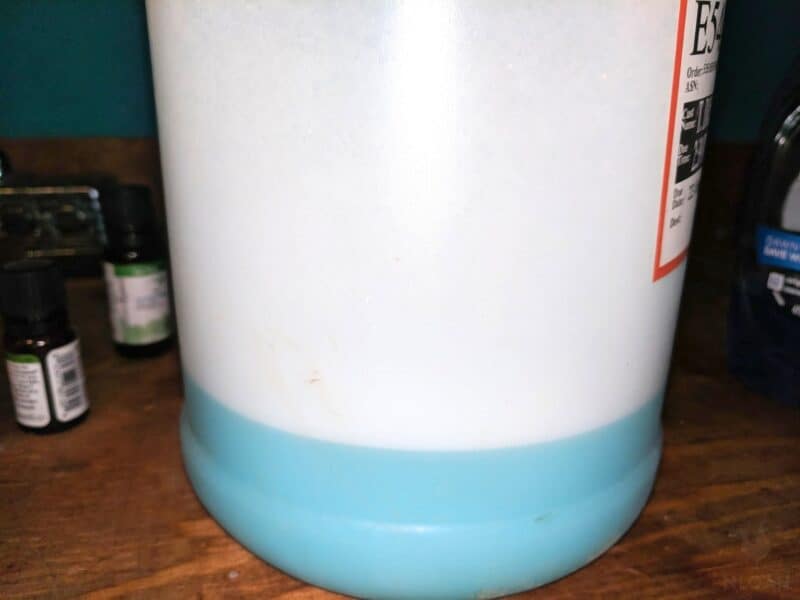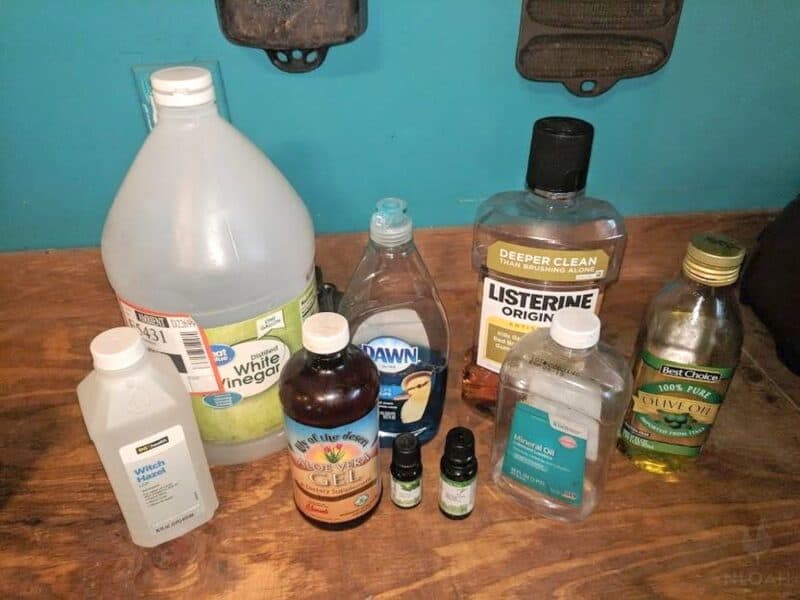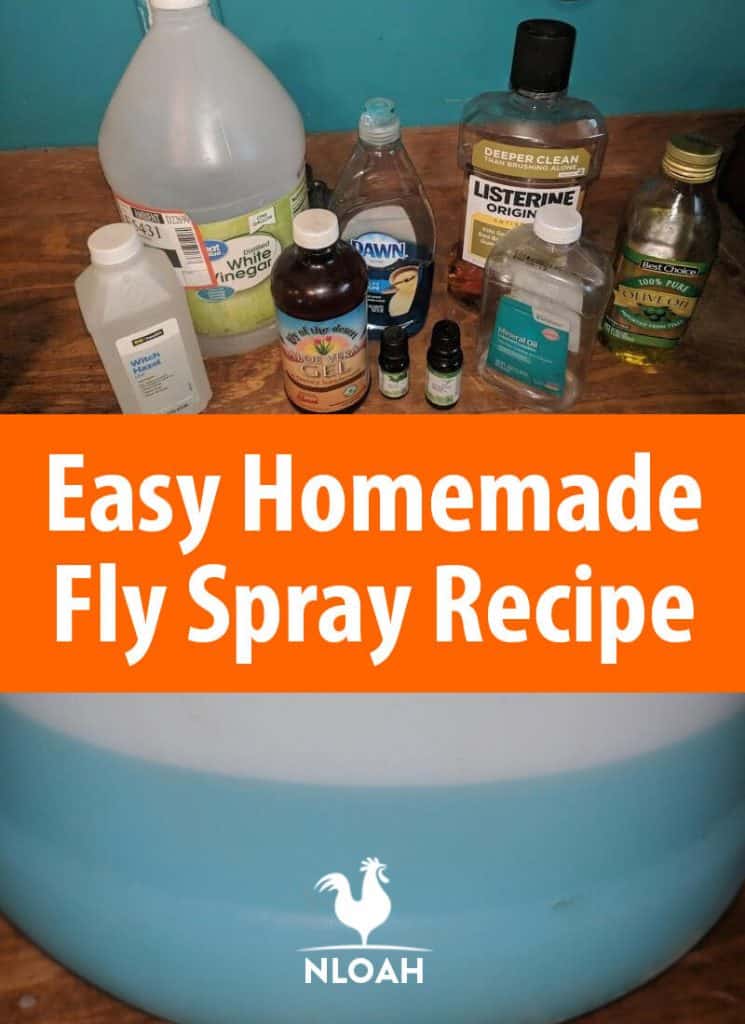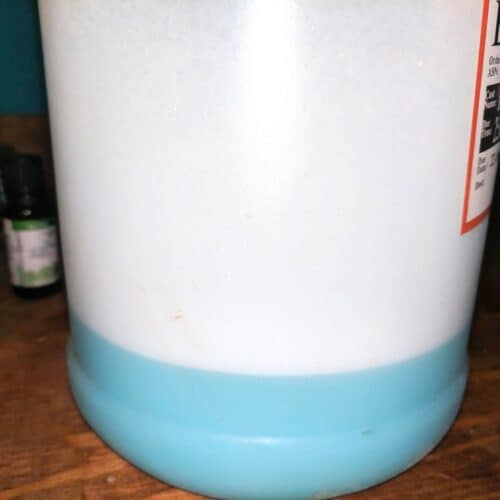Flies are as much of a fixture on any homestead as the chicken coop and a compost pile. Getting rid of flies as well as keeping them and other pesky insects off of your family and livestock becomes an everyday battle once the chill of winter gives way to the warmer temperatures of spring.

Making your own fly spray is not only a quick and easily accomplished task, it is also one that involves absolutely no chemicals and costs mere pennies. I started making my own insect and fly spray while I was still an “in town” homesteader.
Once I learned how efficient it was at thwarting not just flies but mosquitoes and horseflies, I started using it on our backyard livestock too.
Soon, my DIY fly spray became a small town famous, even the Amish wanted my recipe. I actually traded some of my homemade fly spray with our Amish farrier for a bag of his wife’s freshly baked chocolate chip cookies – so I got the tastier end of that deal.
This DIY fly spray costs me approximately $2.50 to make per half gallon, and it keeps for months on end without losing its potency.
My Budget Homemade Fly Spray Recipe
Equipment
- 1 jug
- 1 squirt bottle
Ingredients
- 1 cup liquid dish soap
- 4 cups distilled white vinegar
- 1/4 cup witch hazel
- 2 tablespoons mouthwash
- 4-6 capsules Vitamin E or 3 tablespoons of either aloe Vera juice, mineral oil, or olive oil
- 6 shakes tea tree oil
Instructions
- Mix all of the ingredients together in a jug with a firm-fitting lid or a squirt bottle if only making a small batch.
- Shake the homemade fly spray vigorously for about 30 seconds.
- Pour the fly spray into a squirt bottle.
Video
Usage
Spray the DIY insect repellent dirty onto your skin or onto the fur of animals. When spraying on animals, it is best to ruffle the fur a bit so the spray actually sinks onto the flesh below.
Notes
I tend to keep the big jugs in the distilled white vinegar that comes in, and mix up a batch of fly spray when I have about the right amount of vinegar left. Using a little extra vinegar makes the insect repellent spray more potent.
I have always used tea tree oil around the house, on pets, and livestock without any problem, but I do reduce the amount of any essential oil used when it will be applied to young children and animals – especially tea tree oil.
Puppies, kittens, rabbits, cats, small dog breeds, and chickens, are more susceptible to the tea tree oil exposure than larger animals.

My Next-Level Fly Spray Recipe
This fly spray recipe is designed for application mostly to ground areas, or on the skin of adults and large livestock. It has a high essential oil content that should be reduced by half when spraying on children age four and older and medium livestock.
I do not recommend using this high of a concentration of essential oils on your children and either small or young animals. This fly spray recipe is more expensive to make because of the amount of essential oils used. A half a gallon can cost around $5 to make.
I typically whip up this recipe when I am dealing with horseflies, wasps, and hornets.
Ingredients
- 5 cups of apple cider viengar or distilled white vinegar – apple cider works best with this recipe.
- 3 tablespoons of mineral oil, vegetable oil, or olive oil
- 15 drops of peppermint essential oil
- 15 drops of rosemary essential oil
- 10 drops of tea tree essential oil
- 15 drops of basil essential oil
- 2 tablespoons of Blue Dawn
Directions
- Mix all ingredients in a jug or squirt bottle.
- Shake the mixture vigorously for 30 seconds.
Usage
- You can squirt the DIY fly spray directly onto hovering flies to annihilate them.
- You can soak fabric strips into the spray, and hang them up in a boho decorative manner on string around your porch, patio, or shelter house to deter flies, mosquitoes, and other pests.
- To keep flies and bees away from outdoor trash cans, soak a sponge in the spray and place it in a paper bowl that has been duct taped to the can.
- Pour or squirt the homemade fly spray around outdoor leisure areas and/or livestock pens to keep flies and other insects at bay.
- You can also use this fly spray to make a fly trap. Simply put the spray in a cup, then cover with plastic wrap. Poke a few holes in the wrap. The bugs should fall in the jar, attracted to all the scents in the container, but won’t be able to get out.
Store the homemade fly spray in a container with a firm-fitting lid in a cool dark place until ready to use.
I typically make up a big batch once a month starting in April through September so that I always have plenty on hand to treat livestock, to spray around common areas in the yard, and to squirt all over myself before working in the garden or going on a trail ride.
Recipe Variations
Some people have asked if you can use other types of essential oil in this homemade fly spray to create customized natural fly repellents.
The short answer? You sure can! Here are some of my favorite takes…
- Citronella Oil – Not only does citronella oil smell amazing, but it also repels flies. Add some of this oil to your fly spray recipe and you’ll be ready to take on the summer heat in no time.
- Lavender – Lavender is not only a beautiful flower, but it’s also an effective bug repellent. Add lavender oil or dried lavender flowers to your fly spray recipe for a calming scent and effective bug-repelling properties.
- Geranium Oil – Geraniums are another great source of natural bug repellent. You can add geranium essential oil or dried geranium leaves to your fly spray recipe for an all-natural way to keep away those pesky bugs.
- Lemon Eucalyptus Oil – Lemon eucalyptus oil has been proven as a great insect repellent, so adding it to your homemade fly spray recipe is sure to help keep those flies away. The sweet citrusy aroma will also leave you feeling refreshed!
- Mint – Mint is an excellent natural insect repellent, so adding some mint essential oil or dried mint leaves into your recipe will help ward off any unwanted visitors looking for something sweet.
- Marigold – Marigolds are known for their vibrant colors and fragrant aroma, but they’re also a great bug repellent. Add some marigold petals or essential oil into your homemade fly spray recipe for a bright pop of color and extra protection against those pesky pests!
- Cloves – Cloves are an amazing natural insect repellent due to their strong pungent aroma and antibacterial properties. So don’t forget about adding cloves into your homemade fly spray recipe!
- Lemongrass Oil – Lemongrass oil smells absolutely divine while also being an effective bug repellent. Add some lemongrass essential oil into your recipe for a fresh citrusy scent that keeps the flies away!
- Cedar Oil – Cedarwood is not only known for its woodsy aroma but it’s also known as an excellent natural bug repellent! Simply add some cedarwood essential oils or shavings into your fly spray recipe for extra protection against bugs of all kinds.
- Cinnamon – Cinnamon has long been used as an effective insect repellent due to its strong spicy aroma that drives away bugs naturally! Don’t forget about adding cinnamon essential oils or powder into your homemade fly spray recipe this summer season!
- Witch Hazel – Adding witch hazel extract into our homemade fly spray recipes helps boost the effectiveness of other natural insect repellents like citronella and lavender by helping them stay on skin longer. Plus witch hazel has antiseptic properties which makes it even more beneficial in our recipes!


Tara lives on a 56 acres farm in the Appalachian Mountains, where she faces homesteading and farming challenges every single day, raising chickens, goats, horses, and tons of vegetables. She’s an expert in all sorts of homesteading skills such as hide tanning, doll making, tree tapping, and many more.


Very helpful.. thank you very much for sharing your knowledge with us..God bless you always
I’m whipping up a batch tomorrow!! Thank you so much for these recipes!